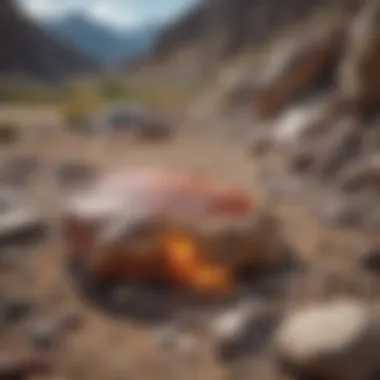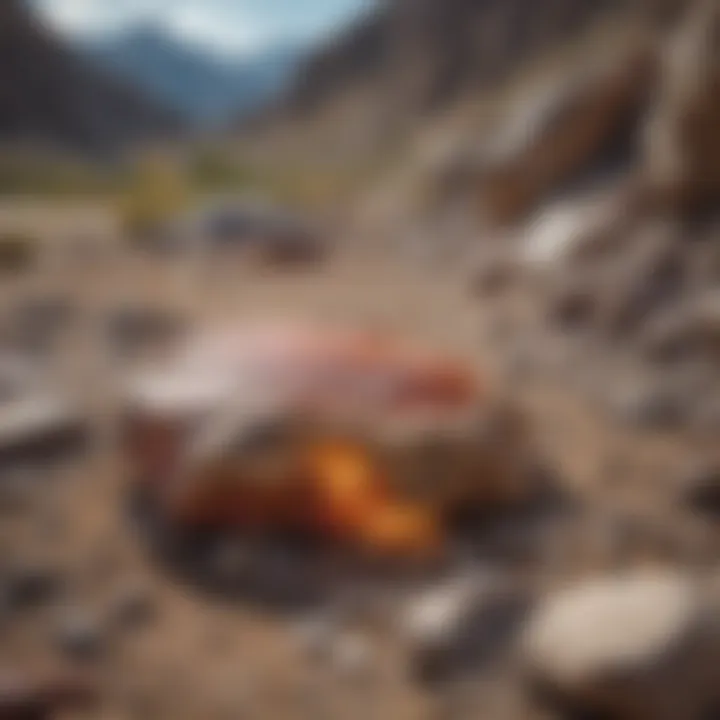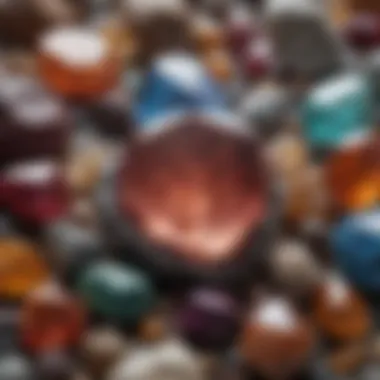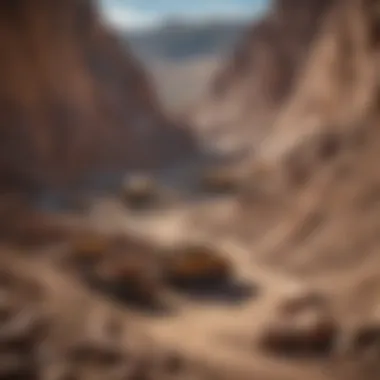Discovering Colorado's Unique Gems and Minerals


Intro
Colorado, with its breathtaking landscapes and rich geological history, serves as a treasure trove for gem and mineral enthusiasts. The state is not just known for its stunning mountains and scenic vistas but also for the fascinating array of gems and minerals that can be found beneath the surface. From the dazzling blue hues of aquamarine to the striking reds of rhodochrosite, Colorado's mineralogy offers a blend of aesthetic beauty and scientific intrigue.
This article sets out to explore the unique gems and minerals that Colorado has to offer, diving into their geological origins, distinctive features, and the historical context surrounding their extraction. In addition to showcasing key locations where these natural wonders can be found, we will touch on collection practices and preservation methods that are essential for both amateur and professional collectors.
Understanding Colorado's gems is more than just an appreciation of beauty; it's about recognizing the stories they tell about the earth's history and the dedicated individuals who unearth them. By providing a comprehensive guide, we aim to cater to rock and fossil collectors, academics, and anyone with a curiosity about the natural world, leading them through a journey that merges passion with science.
In the spirit of exploration, let's kick things off by shining a light on this month's featured collectible.
Prelims to Colorado's Geological Heritage
Colorado's rich geological heritage is not just a backdrop for scenic beauty but a treasure trove of natural wonders waiting to be explored. Its impressive landscapes, marked by the Rocky Mountains and expansive plains, are the result of millions of years of geological processes. This section aims to highlight its significance, particularly within the context of gems and minerals, which are integral to understanding the state's natural history and economic development.
In delving into Colorado's geological heritage, we're not only tracing the origins of the ground under our feet, but also examining how these elements influence the gemstones and minerals extracted from this land. The peaks, valleys, and plains of Colorado are like pages in a book, each telling a story about formation, erosion, and the sometimes tumultuous processes that shaped them.
Understanding this backdrop sets the stage for appreciating the unique characteristics of Colorado's gems and minerals. Each mineral tells its own tale, shaped by temperature, pressure, and chemical environments unique to its location. From breathtaking aquamarines nestled in granite to striking garnets in schist, knowing the geological context enhances both scientific and aesthetic appreciation.
The implications extend beyond just the beauty of gemstones; they influence local economies, attract enthusiasts and collectors alike, and deepen academic studies into geology.
"Every gem tells a story, one that begins deep within the Earth, shaped by forces time has only hinted at."
Thus, exploring this heritage provides a pathway to understanding not only the gems themselves but also the evolution of life and our planet's history, setting a solid foundation for our exploration of Colorado's gems and minerals.
Understanding the Geological Framework
To grasp the full depth of Colorado’s mineral riches, we must first unravel the geological framework that underpins them. The state's geological history is an intricate tapestry woven from diverse elements, forged over eons of time. A key aspect is the crystalline basement rocks that underlie much of Colorado, which are primarily gneiss and schist. These ancient rocks date back to over a billion years, providing a solid foundation for the younger sedimentary rocks that have since settled atop them.
The Colorado Rockies, particularly, are the product of complex tectonic activities. Mountain building, known as orogeny, shaped these formidable ranges. During the Laramide Orogeny, which occurred about 70 million years ago, thrust faulting resulted in the uplift of sedimentary strata, driving the incredible elevation changes we see today. This geological activity played a crucial role in the formation of various mineral deposits.
In addition to the Rockies, elements like volcanism and glaciation further jostled Earth’s resources. Volcanic activity introduced minerals such as zeolites and perlite, while glacial periods left behind pockets rich in quartz and other treasures.
Overview of Mineral Diversity
Colorado's mineral diversity can only be described as dazzling. With over 300 minerals identified, it is a rock hound's paradise. This bounty arises from the state’s rich geological tapestry, where a variety of conditions led to the formation of distinct mineral types.
Among the most notable are:
- Aquamarine: Known for its stunning blue hues, it often forms in granitic environments.
- Garnets: These come in various colors, found commonly in metamorphic rocks.
- Fluorite: Found particularly in the famed Leadville Mining District, with its vibrant hues ranging from purple to green.
- Rhodochrosite: This pink gem is one of the state’s prized finds, celebrated for its unique banded patterns.
Adding to this allure is the presence of rare minerals like vanadinite and wulfenite, often sought after by collectors due to their limited availability and striking appearances. Not to forget, the state is also a hotspot for unique crystallizations and formations due to its varied topography and geological processes.
Overall, the interplay of geological activity has fostered an impressive spectrum of gems and minerals, enriching Colorado's landscape and providing bountiful resources for both recreational collectors and scientific study.
Historical Context of Colorado's Gem and Mineral Industry
Understanding the historical context of Colorado's gem and mineral industry sheds light on how geological treasures have shaped the state’s identity. Colorado’s landscape is not just stunning; it's a showcase of nature’s craftsmanship. Over the years, the discovery and mining of gems and minerals have played a pivotal role in not only the economy of the region but also the cultural and social fabric of its communities. The tale of gems and minerals in Colorado is a narrative woven with passion, ingenuity, and resilience.
Early Discoveries and Their Impact
The story begins in the mid-19th century when intrepid prospectors, driven by the lure of shiny minerals, scoured the rugged terrain of Colorado. The discovery of gold in 1858 set off a frenzied rush that brought people from all corners of the country. However, it wasn’t just gold that glittered in the hills. Less recognized but equally significant finds of gemstones like aquamarine and smoky quartz began to surface, slowly piquing the interest of collectors and jewelers alike.
These early discoveries catalyzed the establishment of thriving mining towns, each boasting its own unique mineral profile. For instance, Leadville, known for its silver, also discreetly held deposits of enticing gemstones. The ensuing rush created a melting pot of cultures, as miners, their families, and merchants flocked to these bustling hubs. People shared stories and techniques, leading to a transfer of knowledge that helped elevate local mining practices. Such early explorations laid down the groundwork and ignited a fascination that persists to this day.
"In a land where beauty thrives beneath the surface, Colorado’s history is etched with the footprints of those who sought its hidden treasures."
Economic Implications Through the Years
As the years rolled on, the economic landscape of Colorado evolved in tandem with the gem and mineral industry. The initial gold rush expanded into a varied mineral extraction economy. By the late 1800s, Colorado was not only renowned for its gold and silver but also for its precious gems. This diversification allowed for a more stable economic foundation. Small businesses began to sprout, giving rise to a local jewelry industry that showcased Colorado's unique gemstones.
In the modern era, Colorado's gem and mineral sector has found a niche in both local artisan crafts and large-scale commercial ventures. Retailers and collectors now explore the state’s diverse mineral inventory, from sparkling fire opals to the deep hues of rhodochrosite. Furthermore, the eccentricities of these minerals often draw tourists eager to explore the “Rocky Mountain High.” Colorado now stands as a beacon for gem enthusiasts and casual visitors alike, providing a sustainable economy that thrives on both collection and conservation.
In summary, the historical context of Colorado's gem and mineral industry illustrates how early discoveries and economic evolution entwined to forge vibrant communities and highlight the significance of these natural treasures, shaping not only the economy but also the cultural heritage of the state.
Prominent Colorado Gems


Gems in Colorado paint a vivid picture of the state's geological splendor and rich cultural tapestry. These stones, crafted over millions of years, speak to the earth's processes and the hands that discovered them. Each gem possesses its own story and value, which has captivated collectors, hobbyists, and researchers alike. In this section, we will explore three standout gems: aquamarine, topaz, and fire opal. These breathtaking specimens not only showcase the diverse mineral wealth of Colorado but also highlight the experiences and passions of those drawn to them.
Aquamarine: The Beautiful Blue
Aquamarine, with its serene blue hues reminiscent of clear mountain lakes, is among the most sought-after gems found in Colorado. This stunning beryl variety originates predominantly from the Himalayas and Brazil; however, the unique geological conditions present in Colorado, particularly in the Rocky Mountains, yield an exquisite quality. Colorado aquamarines often have an excellent clarity and a vibrant, bright blue color that can rival even the best from Brazil.
In the state, most notable deposits are located around the Crystal and Mount Antero areas, where miners have discovered rich veins of this beautiful gemstone. Some collectors have reported finding aquamarines weighing several carats in the region, which only adds to the allure.
Benefits and Considerations
Aquamarine is not just coveted for its beauty; it is also said to have calming properties, making it a favorite among jewelry enthusiasts. As a gemstone, it's quite durable with a hardness rating of 7.5 to 8 on the Mohs scale, suitable for daily wear in jewelry. However, it’s essential for collectors to be cautious when buying aquamarines, as the market can be flooded with synthetic versions or treated stones, which may not hold the same worth.
Topaz: A Stone of Many Colors
Topaz is another gem that flourishes in Colorado, characterized by its diverse color range - from the classic golden to more exotic blues and pinks. This adaptability lends topaz a unique versatility, and it has been cherished in many cultures throughout history.
Key deposits can be found in areas like the Mount Abraham region, famous for producing stunning topaz specimens often used in jewelry. The varying geological formations in Colorado allow for the formation of different color variants, making it a hotspot for gem enthusiasts looking for something special.
Benefits and Considerations
Topaz is appreciated not just for its aesthetic appeal but also for its metaphysical properties. It’s believed to promote clarity of thought and creativity. Its durability, rated between 8 to 8.5 on the Mohs scale, means that it’s suitable for rings and other frequently-worn jewelry. However, potential buyers should remain vigilant and inquire about the stone's origin and clarity, as treatment processes can influence both price and quality.
Fire Opal: A Fiery Treasure
Fire opal, with its warm, fiery orange and red tones, captures the imagination like few other gems. Though primarily found in Mexico, Colorado has also contributed to the popularity of this breathtaking stone. The opals from this region tend to exhibit a brilliant play of color, often basking in hues that mimic a sunset.
Significant finds have been reported in the Lava Creek area, where volcanic activity provided the perfect environment for the formation of opals. Collectors cherish fire opals for their unique appearance and the vibrant glow they bring to any collection.
Benefits and Considerations
Besides their aesthetic charm, fire opals are unique in being relatively less expensive than other semiprecious stones due to their sometimes lower hardness rating of 5.5 to 6.5. They can be more sensitive to temperature changes and scratches, so collectors should handle them with care. Documentation of provenance is crucial here, as it can greatly influence the market value of fire opals.
Fire opals from Colorado have gained recognition for their light diffusion properties, which can create stunning depth in color.
In summary, Colorado's prominent gems — aquamarine, topaz, and fire opal — present not only a riches of natural beauty but also a unique intersection of geological history and human endeavor. Each gem carries its own legacy and significance in the world of gems and minerals, drawing in treasure seekers and collectors for generations.
Notable Colorado Minerals
The role of notable minerals in Colorado cannot be overstated. They represent not just the geological riches of the state, but also the intricate relationships between nature and human activity. Each mineral tells a story, reflecting both the history of our planet and the industrious spirit of those who have sought to uncover its hidden treasures.
The Significance of Rhodochrosite
Rhodochrosite, often called the “stone of love,” is one of Colorado’s most beloved minerals, and for good reason. Found primarily in the Sweet Home Mine located near Alma, this stunning pink mineral features banded patterns that are captivating to the eye. Its unique color arises from manganese, lending it an appealing aesthetic that makes it highly sought after by collectors.
Beyond its visual appeal, rhodochrosite holds cultural significance as well. The mineral is attributed with healing properties and is often used in metaphysical practices. This connection to emotional wellness adds an extra layer of value, making it more than just a collectible item.
"Rhodochrosite reflects the heart. It's a reminder of love and compassion embodied in crystalline form."
In geological terms, rhodochrosite is a carbonate mineral, often forming in hydrothermal veins alongside other valuable minerals. However, the limited locations where it can be found make this mineral rare. Its significance in the world of gems often stems not only from its rarity but also from the skill and knowledge required to extract and work with it effectively.
Rare Minerals and Their Origins
Collecting rare minerals isn't just a hobby; it’s a pursuit enriched by history, science, and a bit of luck. Among the many rare finds in Colorado, vanadinite and wulfenite deserve special attention for their unique characteristics.
Vanadinite
Vanadinite is a remarkable mineral, primarily composed of lead and vanadium, and is often found in distinct hexagonal crystals. This mineral frequently exhibits a stunning red hue, making it visually striking. Found predominantly in the deserts of southern Colorado, vanadinite stands out due to its rarity and the intricate formations typical of its deposits.
One of the primary advantages of vanadinite is its unique appearance, which has made it a popular choice among collectors. It’s often considered a "must-have" for mineral enthusiasts due to its vibrant colors and intriguing crystal structures. However, it should be noted that while vanadinite is appealing, it can also be somewhat brittle, which might make handling a bit tricky for less experienced collectors.
Wulfenite
Wulfenite is another gem-class mineral with a fascinating story. Distinguished by its bright colors, often orange to yellow, it forms in a range of spectacular shapes—sometimes resembling flat plates or pyramids. Found in areas like the Mine La Motte in Colorado, this mineral’s captivating visuals are complemented by its historical significance as a secondary mineral that forms from the oxidation of lead deposits.
The key characteristic of wulfenite is its unique translucence, which captures light beautifully and reveals depths within that may appear to shift under various lighting conditions. Collectors prize wulfenite for its remarkable appearance and for the stories it tells about its formation, adding layers of intrigue to its value.
Nevertheless, like vanadinite, wulfenite can be fragile and requires careful handling. This characteristic makes it imperative for collectors to adopt suitable preservation techniques to ensure these rare specimens are appreciated for years to come.


In summary, Colorado's notable minerals, from the elegant rhodochrosite to the dazzling vanadinite and wulfenite, showcase the rich geological tapestry of the state. Each mineral not only serves as a testament to the natural beauty inherent in our world but also embodies the dedication of collectors and geologists alike to uncover the wonders hidden beneath our feet.
Major Mining Districts in Colorado
Understanding the major mining districts in Colorado is crucial for anyone interested in the state's rich gem and mineral history. These areas are more than just geographical locations; they represent a fascinating blend of natural resources, human endeavor, and economic significance that has shaped the local culture and industry. Each district not only offers unique minerals but also tells a story of exploration, innovation, and community. The gems and minerals harvested from these sites have attracted collectors and geologists alike, transforming Colorado into a mecca for enthusiasts.
The San Juan Mountains
The San Juan Mountains are a hotbed of geological activity, renowned for their breathtaking scenery and mineral wealth. This area boasts an elevation that reaches over 14,000 feet, creating a rugged landscape filled with alpine lakes and towering peaks. The mineral deposits in this region are quite diverse, including valuable resources like silver, gold, and a plethora of colorful gems.
Key Highlights:
- The San Juan Mountains have been actively mined since the mid-1800s when miners flocked to the area during the Gold Rush.
- Noteworthy minerals found here include rhodochrosite, topaz, and various quartz varieties, each telling a different tale of formation and extraction.
- The area is also a popular destination for rock hounds who often seek out these rare gems, adding a recreational aspect to the region's mining legacy.
"The San Juan Mountains present an unparalleled opportunity for collectors to uncover hidden treasures amidst stunning landscapes, blending adventure with discovery."
The Front Range: A Collection Hub
The Front Range serves as the backbone of Colorado, not only geographically but also in terms of gem collection and mining history. Stretching from Wyoming down to New Mexico, this district is easily accessible, making it a favorite among amateur and professional collectors. The Front Range is particularly known for its abundance of various minerals, and it offers a unique mix of sites for collectors to explore.
Characteristics:
- With its proximity to urban centers like Denver, the Front Range allows for easy travel to various collection sites, ensuring that anyone can partake in the thrilling experience of searching for gems.
- Major finds in this area include aquamarine and smoky quartz, both of which have become symbols of Colorado's mineral diversity.
- Local rock and mineral shows emphasize educational opportunities, showcasing the hard work of collectors and miners alike while fostering community pride.
The Leadville Mining District
The Leadville Mining District holds a special place in Colorado's mining narrative. Once considered the"Heart of the Rockies," Leadville is rich in history, having been one of the most productive silver mining districts in the country. The colorful past is reflected in the unique minerals unearthed from the earth here.
Essential Points:
- Leadville is famous for its rich deposits of lead, silver, gold, and zinc, with many historic mines still standing as testaments to its mining heritage.
- Among its prized minerals is the highly sought-after lead minerals like wulfenite and vanadinite that have captivated collectors for years.
- The district is not solely about mining; it has fostered a community centered around mineral collecting, with local fairs and events dedicated to the appreciation of these geological wonders.
Collecting Practices in Colorado
Collecting gems and minerals in Colorado offers not just the thrill of the hunt but also a chance to appreciate the intricate relationship humans have with the Earth. For enthusiasts, knowing how to navigate this space effectively is crucial. Understanding collecting practices encompass more than what meets the eye; it intertwines knowledge of geology with respect towards nature and legal boundaries. This section shines a light on the importance of responsible collecting while highlighting unique practices that can enhance the overall experience.
Best Practices for Limited Collectors
For collectors who don’t have endless resources—whether time, money, or equipment—there are effective tactics to maximize their expeditions. Here are some best practices:
- Research Locations: Knowing where to dig or explore is half the battle won. Reliable resources like local rockhounding groups or online forums on Reddit can offer recommendations on promising spots.
- Gear Essentials: A sturdy backpack, a good map, and proper tools should be the bare minimum. Tools for digging and sifting can be varied; a simple garden trowel might suffice in softer areas. Being prepared means you can make the most out of limited time.
- Stay Safe: Remember to check weather conditions and be aware of any local wildlife. Ensuring safety should never be sidelined. Always let someone know where you’ll be heading.
- Know Your Limits: If you are just starting, don’t overwhelm yourself with the thought of collecting show-stoppers. Begin by looking for common minerals and gradually expand your list.
Collecting doesn’t have to be a grand affair; small, meaningful finds often lead to deeper engagement with the landscape you’re exploring.
Understanding Legal and Ethical Considerations
Navigating the rules around mineral and gem collecting in Colorado is paramount for any gem enthusiast. Beside state and federal laws, many areas have specific regulations that dictate what can be collected and how much can be excavated. Here’s a bit more on the essential aspects to keep in mind:
- Permits and Restrictions: Always ensure you have the necessary permits where required. This is particularly true for protected lands like national parks or wildlife reserves where collecting may be completely off-limits. Violating these laws can lead to hefty fines.
- Respect for the Environment: Always practice ‘leave no trace’ principles. That means filling in any holes you dig and taking any trash back home with you. The Earth is more than just a place to find treasures; it’s a delicate ecosystem deserving respect.
- Cultural Heritage: Some of the areas where gems and minerals can be found may have significant archaeological importance to indigenous peoples. Being aware of and respecting these sites is crucial in ensuring the heritage of our country remains preserved.
"Collecting is a dialogue between people and the Earth, and it should be approached as such. Respecting both will yield a richer experience for all involved."
Throughout this journey, collectors have the potential to learn not only about the gems they seek but also about the rich history and geology of Colorado. By adhering to best practices and understanding legal nuances, collectors can ensure a responsible approach to this multifaceted hobby.
Gem and Mineral Preservation Techniques
Preserving gems and minerals is an essential consideration for collectors and enthusiasts alike. The significance of proper preservation techniques cannot be overstated, given that these natural wonders are not only beautiful but also often irreplaceable. Understanding how to care for these pieces helps maintain their beauty and value while allowing for future enjoyment and study.
When gems and minerals are not properly stored or maintained, they can suffer a range of damage. Factors like exposure to moisture, direct sunlight, or even abrasive contact can significantly diminish their quality. Collectors must be proactive in safeguarding their treasures to ensure that future generations can appreciate their historical and geological significance.
Storage Solutions for Collectibles
Selecting the right storage units for collectibles is crucial to ensuring their longevity. Here are a few effective storage options you might consider:
- Display Cases: Glass display cases offer protection against dust and scratches while allowing light to showcase the beauty of the gems and minerals. Ensure that the display cases do not have features that may cause abrasion or chemical reactions with the stones.
- Protective Bags and Boxes: Soft, anti-static bags are often appropriate for smaller pieces. Using cloth or felt-lined boxes can keep stones safe while stored and helps cushion them against shocks.
- Labeling: Don’t forget to label items clearly with their names and any relevant information. This makes it easier to locate specific items and understand their origins.
- Climate Control: Make sure the environment is suitable. Gems and minerals thrive in stable conditions. A cool, dry space with minimal temperature fluctuations is ideal. Avoid attics or basements where conditions can change drastically.


Storing gems is not just about putting them away. It’s about crafting an environment where they can thrive. That’s the secret sauce to keeping your collection in top form.
Cleaning and Maintenance
Regular cleaning and maintenance is key in maintaining the integrity of your gems and minerals. However, it’s essential to approach cleaning with care to avoid any potential damage. Here are several approaches to ensure your collection stays pristine:
- Gentle Dusting: For routine maintenance, a soft brush or microfiber cloth is an excellent tool for dusting. Avoid any harsh materials that can scratch the surface.
- Cleaning Solutions: Use gentle, pH-balanced soaps mixed with water for deeper cleaning. Avoid using any chemicals or abrasive cleaners that could harm the surface of your collectibles. For instance, a simple mix using a few drops of dish soap in warm water will usually suffice.
- Rinsing and Drying: After washing, make sure to rinse thoroughly with clean water and dry with a lint-free cloth, avoiding friction that could dull the surface.
- Avoid Submerging: Some stones may absorb water or deteriorate when exposed to it. Always research cleaning techniques specific to each mineral type before proceeding.
"An ounce of prevention is worth a pound of cure" – this timeless saying applies vividly to gem and mineral maintenance. Investing time in proper cleaning and storage will yield dividends in the beauty and durability of your treasures.
In summary, preserving your gems and minerals involves careful thought about storage and maintenance practices. Understanding what works best for your collection is vital in extending its life and ensuring that the geological tales each piece holds can be shared for years to come.
Educational Resources for Enthusiasts
Understanding the world of Colorado's gems and minerals goes far beyond simply collecting; it involves an appreciation for the geological nuances, history, and ongoing advancements in the field. For enthusiasts looking to deepen their knowledge, a variety of educational resources can shed light on these awe-inspiring treasures. Access to such resources aids not only in honing your collection skills but also fosters a sense of community among kindred spirits.
Local Museums and Exhibits
Visiting local museums can be an exhilarating experience for gem and mineral enthusiasts. These establishments serve as custodians for both the past and present, showcasing diverse exhibits that educate the public about the geological history of Colorado's gems.
- The Denver Museum of Nature & Science offers extensive exhibits related to geology. Their mineral collection is vast and varied, and you can often find special exhibitions dedicated to specific gemstones or mineral types.
- The Telluride Historical Museum provides insights into the mining booms of the past and highlights the gems that came from those activities. They hold artifacts that tell stories, weaving the fabric of Colorado's rich geological past.
- For a more hands-on experience, the Rocky Mountain Mineral Law Foundation sometimes holds educational events, teaching enthusiasts about the legal aspects of mineral rights and collection.
These museums not only exhibit stunning crystals and gems but also engage with various activities like workshops and guided tours, making them the perfect start for any budding collector.
"Museums not only display artifacts but weave stories that connect people to the earth's history."
Online Platforms and Communities
With the rise of digital connectivity, enthusiasts can now explore their passion from the comfort of their own homes. A plethora of online platforms and community forums are available, allowing rock and mineral collectors to share knowledge, showcase their finds, and connect with fellow aficionados.
- Reddit has dedicated subreddits like r/mineralcollectors where you can interact with experienced collectors. It’s a space to ask questions, seek advice, and even post images of your finds for feedback. This community-driven approach fosters learning through real-life experiences.
- Social media platforms like Facebook have a myriad of groups focused on gem and mineral collecting. Here, seasoned collectors often share tips on preservation and identification, keeping the learning continuous.
- Websites like Mindat.org offer extensive mineral databases, and forums that allow enthusiasts to dive deeper into specific minerals while connecting with other collectors.
Engaging with these resources encourages an ongoing dialogue about collecting practices, legal considerations, and preservation techniques. Overall, they bridge the gap between novice collectors and experts, allowing knowledge to flow freely in a shared passion for geology.
Future of Colorado's Gem and Mineral Exploration
The future of exploring for gems and minerals in Colorado is not just an extension of what has come before; it represents an evolution into a realm shaped by technology, environmental consideration, and a relentless pursuit of knowledge. Understanding this evolving landscape is essential for enthusiasts, collectors, and academics alike. Colorado, rich in geological diversity, still holds secrets waiting to be uncovered. As we look forward, several aspects emerge that bear significant relevance to continuing this journey.
Innovations in Mining Technology
Advancements in mining technology are at the forefront of renewed exploration efforts. Innovative techniques—notably in remote sensing and 3D geological modeling—have transformed how miners and geologists approach extraction. For instance, drones equipped with aerial geological imaging can cover large tracts of land quickly, pinpointing areas that may be rich in gems without extensive groundwork. This efficiency not only saves time but dramatically reduces the footprint left on the environment.
Moreover, sophisticated data analytics allows for better predictive modeling of mineral locations. By analyzing geological data in polygons and grids, contemporary technologies guide explorers toward areas previously thought unfruitful. This means less guesswork and more directed effort in finding rare minerals that may define the next era of Colorado's geographic story.
Another key area is the embrace of sustainable practices. With technologies for reducing waste and minimizing impact on local ecosystems, mining can adapt to modern environmental standards. Techniques like hydraulic fracturing, which is less invasive than traditional methods, are becoming common. Such advancements make it possible not only to uncover Colorado's treasures but also to do so responsibly.
Potential Areas for New Discoveries
One can hardly traverse Colorado's diverse landscapes without realizing the vast potential for new discoveries. Certain regions, particularly less explored districts, beckon with promise. The Ute Mountain area, for example, still holds many of its geological secrets tightly guarded. Its rugged terrain, coupled with the remoteness of access, dissuades many explorers but suggests that beneath its surface might lie undiscovered gems.
In addition, the San Juan Mountains continue to be intriguing to geologists and enthusiasts alike. While known for its astonishing array of minerals, the area still presents numerous opportunities for discovery—especially in locations where past mining activity has unearthed clues about what might still be waiting underground.
Furthermore, there’s growing interest in less traditional minerals like lithium and rare earth elements due to their increasing demand in tech industries. Colorado, with its plethora of geological formations, could be a key player in this sector, advancing the state's role in both the gem and mineral market and the larger economic framework.
"The future exploration of Colorado's minerals is as much about the land as it is about technology and ambition."
As we reflect on these possibilities, it becomes clear that the future of gem and mineral exploration in Colorado is ripe with opportunity. New technologies and dedication to responsible exploration will keep this tapestry of geological marvels vibrant and ever-evolving.
Epilogue: Reflecting on Colorado's Gem and Mineral Legacy
As we reach the end of this exploration into Colorado's gems and minerals, it’s important to reflect on the profound legacy these natural treasures have left in both the cultural and geological fabric of the state. Not only do these stones and minerals tell a story of Earth's tumultuous history, they also highlight the intricate dance between nature and human endeavor.
Summarizing the Geological Impact
The geological landscape of Colorado plays a transformative role in understanding its gems and minerals. This state is not just a picturesque backdrop for geological activity; it's a dynamic arena where geological processes have unfolded over millions of years. The Rocky Mountains, formed through complex tectonic movements, have birthed a plethora of mineral deposits which are significant to gemology experts and enthusiasts alike.
One can't help but admire the intricate formations and stunning colors of the gems sourced from Colorado. For instance, the way aquamarine gleams with a serene blue, and how rhodochrosite stands out with its pinkish-red hues, reflects the defining geological conditions in which they were formed. Understanding this contributes to a deeper appreciation of not just the beauty but the scientific significance behind these minerals—how their very existence is bound in the Earth’s processes.
"The gems and minerals of Colorado are more than aesthetic treasures; they are historical witnesses to the planet's geological evolution."
Encouraging Continued Exploration
Given the vast potential that still lies within Colorado’s mineral-rich grounds, it’s crucial to encourage ongoing exploration among both seasoned collectors and newcomers. Every rock and gem holds stories waiting to be uncovered, and the tale of Colorado’s geological heritage is far from complete.
Adventure awaits in numerous mining districts yet to be thoroughly explored and many lesser-known localities brim with hidden treasures. Enthusiasts are urged to engage not only in collection but also in the environmental and ethical restoration of places previously stricken by mining activities. Learning and participating in responsible collecting practices can foster a relationship that promotes sustainability while preserving Colorado’s natural heritage.
Inclusion of emerging technologies and methodologies in mining paves the way for better discovery techniques. Who knows what rare minerals lie beneath the surface, waiting for the curious to unearth them? It’s a community effort, combining passion with a responsible approach to protect and honor this rich mineral legacy for future generations.



